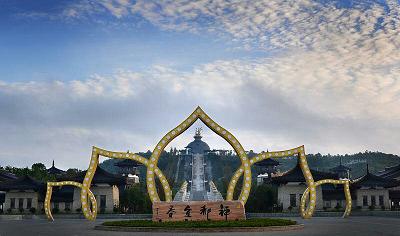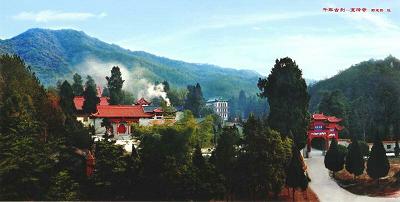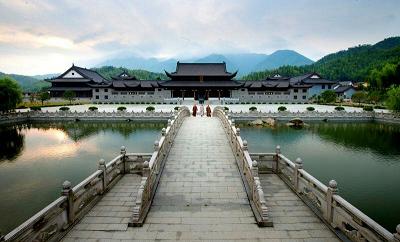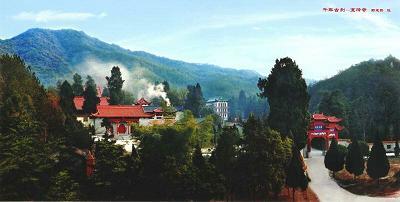
The city of Yi Chun in Jiangxi province won its name through springs here, which are considered to be “cool in summer, warm in winter, beautiful and temperate like spring, pleasant and agreeable to drink”. Except for hot springs rich for selenium in Wentang town, there are still more famous scenic spots here, like the beautiful Mingyue mountain and related culture about the Moon, Sanzhualun in Jing’an county, Gezao mountain in Zhangshu city, Hongzhou kiln in Fengcheng city, Blue and White Porcelain of Yuan Dynasty in Gao’an county, etc. They are all worth seeing and visiting. The famous Chinese ancient writer Han Yu (768-824) in Tang dynasty once wrote the lines: “Far away as Yichun seems to be, it is a land you all expect to see”. Compared with other places, Yi Chun obtains one more advantage: religious background, especially concerning Chan Buddhism, besides its wonderful natural environment and rich cultural relics.
Chan, which originated from Bodhidharma in India, was named as “Chan”, because this religion was first passed to only one person before The Sixth Patriarch Huineng, just like Yao, Shun, Yu, those ancient tribal leaders, passing their power to those who were more capable. The Sixth Patriarch Huineng first made “Dun Wu” (Sudden Enlightenment) become a standard doctrine of Chan, and localized Chan Buddhism in China. And then after the great efforts of those religious leaders including Qingyuan Xingsi, Nanyue Huairang, Mazu Daoyi, Baizhang Huaihai, Chan developed into five branches and became the most widespread school of Buddhism in China. Even though Chan did not come into being in Yi Chun, it grew into a mature religion and prospered here. Since Tang dynasty (618A.D.-907A.D.) and Song dynasty (960A.D.-1279A.D.), Chan Buddhism was brought to Yi Chun and developed very fast here with fruitful achievements. Consequently, Yi Chun became a sacred land of Chan Buddhism. In 2011, master Hsing Yun, the 48th descendant of the Rinzai school as well as abbot of Foguang Mountain in Taiwan, came to Yi Chun to visit the root of Chan Buddhism and wrote the title of “Land of Chan Buddhism, Yi Chun” to the city. Master Yicheng, who is president of Buddhist Association of China, also wrote “Yi Chun is a sacred land of Chan Buddhism”. Evidently, this is by no means coincidence for Yi Chun, since Yi Chun’s historical importance in the development of Chan Buddhism in China was both affirmed by the two Chan Buddhist masters from two sides of the Taiwan Straits.
Yi Chun is considered to be the “Land of Chan Buddhism”, because three most important Chan Buddhist masters made great achievements here. It is widely acknowledged that the Sixth Patriarch Huineng first developed the doctrine of Chan Buddhism in China; Mazu Daoyi advocated the constructions of Bodhimanda; Baizhang Huaihai first established the religious regulations in Chan Buddhism. Here in Yi Chun, Huineng passed Chan doctrines on to his disciples. In Jing’an county, Mazu Daoyi founded Baofeng monastery, an important Bodhimanda, where he also passed away. In Fengxin county, master Huaihai practiced Chan Buddhism and established “Tian Xia Qing Gui” (religious regulations for all Chan Buddhists) there. In the history of Buddhism, two important religious reformations took place in Yi Chun, which are well known as “Mazu founded Forest monastery, while Baizhang established Monastic regulations”.

Forest monastery solved the problems of “hardware”, concerning accommodation and daily livelihood. In the early period of Chan Buddhism, Bodhidharma and the Third Patriarch Sengcan wandered around the world without a permanent shelter, and begged to survive. Then from the Fourth Patriarch Daoxin, Chan Buddhism began to deal with issues concerning Chan monks’ living and accommodation. But there was still no whole system to completely solve the problems. At that time, only a few masters of Chan Buddhism were apparently enrolled in some legal monasteries. However, they actually did not live in the monasteries, and still lived in caves, or thatched shelters. Most Chan monks did not have Du Die, the legal certificates issued by the government to the monks, or were they enrolled in any monasteries. In this case, their social activities cannot be ruled by the government and it was difficult to trace the track of their lives. Without a permanent shelter caused problems in two aspects: on the one hand, because a large number of Chan Buddhists wandered in the society without sufficient records of their behaviors, and did not have a steady job but beg to live, they became a threat to the peace of the society. On the other hand, without a fixed place to practice Chan Buddhism, the Chan Buddhists would have fewer opportunities to communicate with each other, which was evidently bad for the development of Chan Buddhism. To solve this problem, Mazu Daoyi began to found more and more Forest monasteries. He also established important rules including gathering his disciples to teach them Chan Buddhism together, doing manual work together, as well as practicing Chan Buddhism together. It could be concluded as the saying “gathering Chan Buddhists to build the Forest monasteries and religious regulations allowing them to focus on the practice of Chan Buddhism”. Mazu Daoyi founded 48 Bodhimanda in Jiangxi province, and most of them are located in Yi Chun. From then on, Chan Buddhists settled down and had their own places to practice Chan Buddhism, which changed their previous habits of wandering. Mazu emphasized that agriculture was as important as Chan Buddhism, and changed the way of Chan Buddhists’ living through begging rather than working by themselves, which guaranteed that those Chan Buddhists could live independently all on their own. The Sixth Patriarch Huineng once predicted that “in the future ‘Maju’ will promote Buddhism to people across the world”. Mazu Daoyi is that “Maju”, whom Hu Shi (1891-1962), a famous Chinese scholar once commented as “the greatest master of Chan Buddhism in China”. Mazu founded Forest monasteries, which provided basic material foundations for Chan Buddhism to develop and prosper in China and even in the world. Therefore, he is regarded as one of the most prestigious figures in the history of Chan Buddhism in China.
The sacred rules and restrictions had solved the “software” problem in the development of Chan in China. Then Buddhist monasteries increased gradually in number and scale, and there appeared more and more monks, too. Management of these monasteries became a serious problem. On the one hand, the actual state of living and production contradicted the traditional discipline, which forbade the monks from growing crops. On the other hand, with a fixed abode, increased products, more and more respect and admiration from the common people and abundant offers and donations, the Master found it difficult to run the monastery, to regulate the collective life, to organize the work and to distribute products. Under such circumstance, Baizhang Huaihai, disciple of Mazu Daoyi, made up his mind to reform. He moved to Baizhang monastery and devoted himself to research. After a careful study of the national condition, geography and fork culture of China, he borrowed a suitable part from Mahayana and Hinayana, and worked out a new management system, Baizhang Regulations, the first management code in Chinese Buddhism. Huaihai proposed in the Regulations that one should not eat without work and he set the example. He institutionalized many of the important regulations. When it came to Song Dynasty, Baizhang Regualtions had been made as the management regulations pursued by all monasteries all over the country, and it is still used today. BaiZhang Regualtions is an important contribution Huaihai made to Chan in China. It guaranteed the dignity, nobility, authority and mysteriousness of Buddhism. It helped to sinicize Chan in China. And it promoted the sustainable development of Chan in China from an institutional level.
Yichun is considered to be land of Chan Buddhism, because Chan was standardized and prospered in Yichun. When teaching Huike, his successor, Master Dharma made a verse:
To this land I came,
For salvation of the people
By way of teaching;
Like a flower I am,
Five leaves I will have,
And fruit is sure to come.
The flower refers to Dharma, and the five leaves refer to the five branches of Weiyang, Linji, Caodong, Yunmen, Fayan. After the flower developed five leaves, Chan became the largest sect of Buddhism in China. Later, there appeared Yangqi sect and Huanglong sect under the branch of Linji. Then there were totally “five branches or seven sects”. Thus Zen reached a period of great prosperity in China. It is the realization of Dharma’s prophet “Like a flower I am, five leaves I will have, and fruit is sure to come.” From Huineng to five branches, Chan’s two hundred years of development was deeply rooted in Yichun, which, in return, provided a fertile soil to the gestation, multiple, growth and prosperity of each branches of Chan.
Among five leaves of the flower, three of them are in Yichun. They are the sects of Linji in Huangbo, Yifeng; Weiyang in Yangshan, Yuanzhou ; Caodong in Dongshan, Yifeng. The direct descendants of Mazu Daoyi and Huaihai of Baizhang set up the sects of Weiyang and Linji. Both founders of Weiyang and Linji were the disciples of Huaihai of Baizhang. Lingyou of Weishan first studied under Huaihai in Baizhang Mountain. Later he moved to Weishan in Hunan province. Huiji, disciple of Lingyou, moved back to Yangshan, Yichun. It was Huiji who established the sect of Weiyang. That is why Xiyin monastery in Yangshan is regarded as birthplace of Weiyang sect of Chan. Xiyun of Huangbo also studied under Huaihai in Baizhang mountain, then he moved to Huangbo, Yifeng. His disciple, Yixuan, moved to Linji in Hebei province and began the Linji sect of Chan. Therefore, Huangbo monastery is regarded as the birthplace of Linji sect. Liangjia, the founder of Caodong sect, was the disciple of Tansheng of Yunyan. Tansheng also studied under Huaihai for twenty years. When Liangjia travelled to Dongshan, Yifeng, he established Guangfu monastery. Gradually this monastery won great fame. Then his disciple, Benji, preached in Yihuang, Jiangxi province. Afterwards, the doctrines passed in this line were regarded as Caodong sect. Among the five branches of Chan, Yunmen and Fayan appeared in Five Dynasties. These two branches, though not originated in Yichun, have deeply rooted in Yichun, because many of their disciples have settled on Yichun. Fanghui, the founder of Yangqi sect, was born in Yuanzhou and became a monk in Jiufeng mountain in Shanggao. Huinan, the founder of Huanglong sect, was also a disciple of monasteries in Yichun. Thus it can be concluded, all the “Five Branches or Seven Sects” of Chan have some direct or indirect connections with Yichun. In recent years, when monks of South Korea, Japan and Vietnam came to seek their roots in China, most of them would come to Yichun to worship their root monastery of Chan Buddhism. Thus, the cultural exchange and international tourism of Yichun, for the time being, are mostly based on Buddhism.

Yichun is a land of Chan Buddhism, because there have been preserved a lot of important Chan cultural remains and legends. Mazhu Pavilion in Jingan Baofeng Temple, where Mazhu Daoyi practiced Chan, has gone through wind and rain for a thousand years since it was built in Song dynasty and is still in good condition. Fengxin Baizhang Temple built by Huaihai has been illuminated by the Buddha light that was handed down from generation to generation. The four Chinese characters “Tian Xia Qing Gui”, meaning “Regulations for all Chan Buddhists in the world”, written by the great calligrapher, Liu Gongquan and later inscribed on the huge stone of Baizhang Mountain, survived more than a thousand years and is still vigorous and forceful. The ancestral Chamber of Weiyang sect, Xiying Temple, has been famous since Song and Yuan dynasty. The inscribed board of “Great Yangshan Temple of Peace and Prosperity” was given by the Emperor Renzong of Yuan dynasty, who ordered the great writer of the time Chen Jufu to compose “tablet for rebuilding Great Yangshan Temple of Peace and Prosperity” and the calligrapher Zhao Mengfu to write it down for inscription, and the tablet was cherished as a piece of invaluable calligraphic art and amassed in “San Xi Tang Authoritative Collection of Calligraphy” compiled by the Emperor Qianlong in Qing dynasty, passing down till now. The ancient chamber of Linji sect, Huangbo Temple, has been regarded as the sacred place for worship by the monks, with existing pagodas as much as 69 for masters and abbots. Yifeng Dongshan was not only the originating place of Caodong sect, but also a famous resort with towering old trees, warbling small brooks. Besides the ancient relics such as Enlightenment Bridge, Night-closing Stone and the inscriptions on precipices, there are Liangjie Ancient Tower and the tower woods on Night-closing hill, all of which have attracted crowds of Japanese monks to visit. There are also left over many legendary stories. It is said that the emperor Xuanzong of Tang dynasty met a pure, simple and pretty girl when he fell into a misfortune and served as an acolyte in Baizhang Temple, but he dared not do anything because he was afraid of going beyond half a step further of the strict rules of the temple. Later after he went back to the palace and took the throne, he issued a decree to send for the girl. However, the girl was scared by the emperor’s messengers, and killed herself with a rope hung on the house. At hearing the news, the emperor’s heart was broken and ordered to bury the girl with a funeral of an imperial concubine. The girl was buried at the hill slope on the left side of Baizhang Temple and a temple of Imperial Concubine was built there to memorize her.
In reviewing the history of China’s Chan Buddhism, Yichun can be acknowledged as a historic and important place. The ancestral chambers of various Chan sects concentrate in this pure land, and innumerable Chan masters spoke the dharma among the mountains. There are nearly 20 Chan temples scattered in Yichun’s counties and districts, making up the 250km Chan gallery, colorful and dazzling. In history, many senior Chan masters preached Buddhism here, such as Xiyun in Huangbo, Huiji in Yangshan, Liangjie in Dongshan, Huinan in Huanglong, Fanghui in Yangqi, Liaoran in Moshan. Thanks to Chan, some eminent figures left their footprints here, like Hanyu, the emperor Xuanzong of Tang, Liu Gongquan, Pei Xiu, Lu Xisheng, Huang Tingjian, Fan Dacheng, etc. All these Chan masters and famous cultural persons accumulated and communicated here, leaving much told over tales and writings, which made Yi Chun a land of Chan to be formed and go prosperous.
History brought Yi Chun abundant religious resources---a precious historical and cultural treasure, which today we should cherish much. By protecting the remains of Chan culture, exploring its rich cultural relics and strengthening tourism development and cultural advertisement, we can make Yi Chun a real “Sacred Land of Chan”, “City of Chan Buddhism in the World”, famous at home and abroad. (Contributed by Zhu Hong)




 A single purchase
A single purchase









